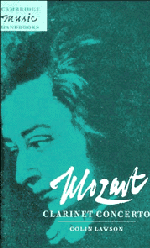Book contents
- Frontmatter
- Contents
- List of illustrations
- Preface
- 1 The eighteenth-century clarinet and its music
- 2 Mozart, Stadler and the clarinet
- 3 The genesis and reception of the Concerto
- 4 Stadler's clarinet and its revival
- 5 Mozart's original text
- 6 Design and structure
- 7 Performance practice
- Appendix 1 A review of the Breitkopf and Härtel edition in the Leipzig Allgemeine Musikalische Zeitung, 4 (March 1802)
- Appendix 2 Surviving instruments
- Appendix 3 A list of works composed by Mozart's clarinettist, Anton Stadler
- Notes
- Select bibliography
- Index
6 - Design and structure
Published online by Cambridge University Press: 05 June 2012
- Frontmatter
- Contents
- List of illustrations
- Preface
- 1 The eighteenth-century clarinet and its music
- 2 Mozart, Stadler and the clarinet
- 3 The genesis and reception of the Concerto
- 4 Stadler's clarinet and its revival
- 5 Mozart's original text
- 6 Design and structure
- 7 Performance practice
- Appendix 1 A review of the Breitkopf and Härtel edition in the Leipzig Allgemeine Musikalische Zeitung, 4 (March 1802)
- Appendix 2 Surviving instruments
- Appendix 3 A list of works composed by Mozart's clarinettist, Anton Stadler
- Notes
- Select bibliography
- Index
Summary
The discussion and analysis which follow may be read in association with any published score of the Concerto. However, a reconstruction for basset clarinet has been assumed throughout, so that editions for normal clarinet will not always correspond in every detail.
Background
From an early age Mozart found the concerto a natural mode of expression. During 1767 he arranged sonatas by other composers as concertos by adding orchestral accompaniments (K37 and K39–41), and he developed a number of structural innovations in the four original solo concertos (K175, 238, 246 and 271) which followed. After his move to Vienna a further trio of piano concertos (K413–15) dating from 1782 preceded the fourteen mature works (from K449 onwards) with which Mozart radically expanded the scope of the genre in terms of form, texture and idiom. In addressing this most highly organised of instrumental forms, blending sonata, concerto grosso, aria and ritornello, Mozart alone realised that the concerto could be transformed from mere entertainment into a structure which was quite distinct from the symphony or sonata. His dramatic music inevitably became an especially potent influence; as one celebrated writer has put it, ‘Mozart found his greatest, most sincere range of expression in opera, and the most beautiful passages in the concertos are those wherein operatic Mozart quivers beneath the galanterie and virtuosity of the concert room’.
- Type
- Chapter
- Information
- Mozart: Clarinet Concerto , pp. 60 - 71Publisher: Cambridge University PressPrint publication year: 1996



